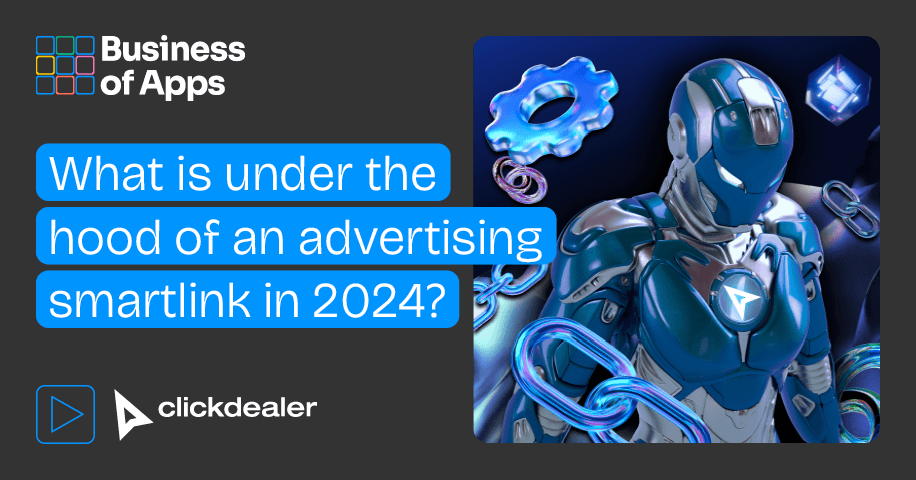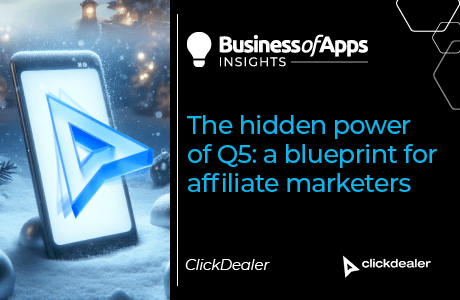Generative AI has completely taken over the advertising automation conversation, firmly cementing itself in every headline for the past few years. It is no wonder, considering that its capabilities can be experienced first-hand by anyone with a bit of free time and access to the internet. Advertising technologies that require performance advertising know-how and a deeper investment of time and resources are understandably left out of the hype cycle, but that doesn’t mean there are no exciting developments to speak of.
Do self-optimizing campaigns run by AI algorithms sound like something that might change the performance marketing industry in the next decade? Then let’s talk about the latest features of smartlinks. But first, a quick refresher on how the technology works.
What is a smartlink and how does it work?
Smartlink is a technology that directs the user to a relevant product based on their location, device, connection type, screen resolution, and other parameters set up by smartlink developers.
It works in conjunction with a TDS (Traffic Distribution System), selecting the product and landing page most likely to convert the user from hundreds or thousands of available ones in a matter of seconds.
There is a common misconception that smartlinks are primarily used for initial GEO tests and are mostly aimed at beginners who are not experienced enough to find the best offers for their traffic. This might have been true five years ago, but the technology has progressed beyond that, and running a smartlink is now the optimal choice for several verticals, especially if you have mixed traffic from several countries.
However, to find a smartlink that can outperform traditionally managed campaigns, you would have to go beyond those created with a smartlink builder provided by tracking platforms, and instead, look for an in-house developed product. Let’s break down the differences between the two.
Standard smartlink vs. custom smartlink
Standard smartlinks use a basic set of tracking parameters to determine the best creatives and offer for the user: country, device, OS, connection type, and operator. A custom-built in-house smartlink analyzes additional characteristics such as city, user age, time of day, and other parameters.
With the increased range of tracking parameters, reporting will also be more informative and allow affiliates to make precise adjustments to their traffic.
Custom smartlinks use machine learning algorithms to precisely analyze and predict user behavior based on a wide range of data points and historical data. Standard smartlinks use static algorithms that don’t self-optimize.
Unlike regular smartlinks, custom-built ones can be integrated with fraud prevention solutions designed to monitor fraud patterns specific to the verticals the link focuses on.
In-house smartlinks have teams of copywriters and designers constantly monitoring advertising trends and updating the pool of creatives with high-performing ads.
Finally, when working with an in-house smartlink, affiliates get assigned a dedicated manager who ensures any technical issues get resolved quickly and provides insights based on the affiliate’s traffic and setup.
What is the best way to track a smartlink’s performance?
The number one all-encompassing metric used to evaluate the performance of an offer is EPC. That doesn’t apply to smartlinks because a smartlink doesn’t only pull up a relevant offer—it also matches it with creatives. The most suitable metric to track with that in mind would be EPV (earnings per visit). It helps monitor the affiliate’s earnings from each click on the link, factoring in both the users who completed the desired action and those who bounced from the pre-lander.
It is also important to remember that traffic sources vary highly in traffic quality. When comparing the average conversion rate on pop-ups to the same metric for email, the difference is enormous. That’s why effective smartlink optimization is not about clicks, it’s about leads. The vertical plays an important role in optimization as well. In some verticals, the target action is a registration, in others, it can be an install, a deposit, or a purchase, and calculations need to be adjusted accordingly to get an accurate picture of campaign performance.
Scaling smartlink campaigns is easy
Smartlinks are often discounted by performance marketers because of the misconception that it is impossible to effectively scale thousands of offers at once. In actuality, it is easier than scaling campaigns on individual offers. Most factors limiting the scaling potential in individual offers don’t apply to smartlinks. An offer can have a lead cap set up by the advertiser to control their campaign budget. With the multitude of offers built into a smartlink, even if all of them are capped at certain amounts, it would take a tremendous amount of traffic to fill them all.
Then there is the factor of market competition. A campaign can take a dip when a brand falls out of favor in a saturated market. When you simultaneously run dozens of top brands whose performance is evaluated constantly using historical data and metrics from currently running campaigns, that ceases to be an issue.
With these factors out of the way and algorithms handling campaign optimization, it can be argued scaling a smartlink campaign is easier and more efficient than handling every aspect of taking a usual performance marketing campaign to the next level.
Conclusion
Performance marketers who say that smartlink technology has hit its peak are not aware of the strides being made by the companies who keep working on them. Custom-built smartlinks are introducing major new features every year and gradually taking over verticals with fixed-payout payment models. With the rapid advancement of AI technology, the next major step in advertising automation might happen sooner than expected.
Find out more about smartlinks here.









